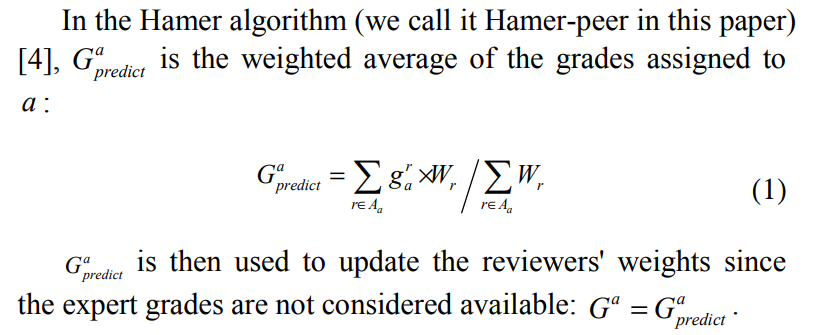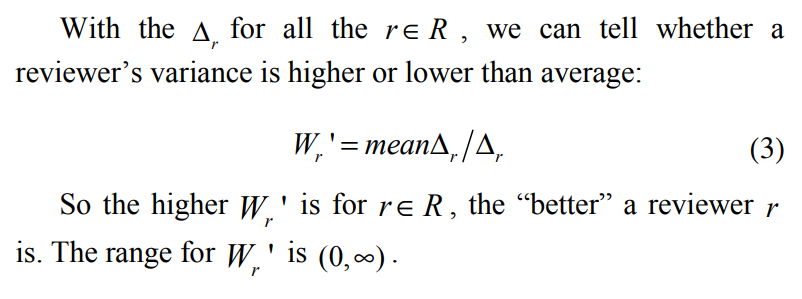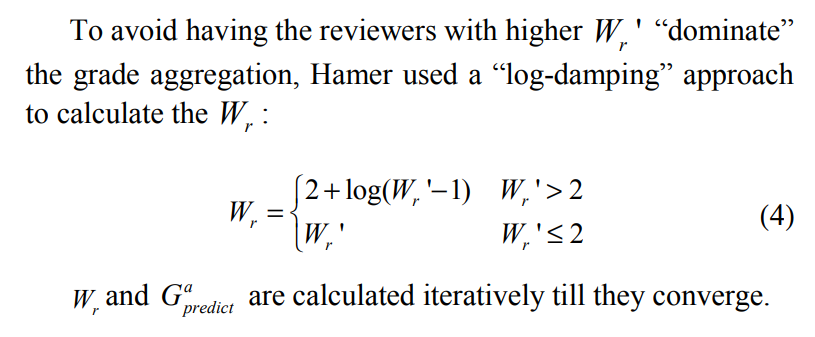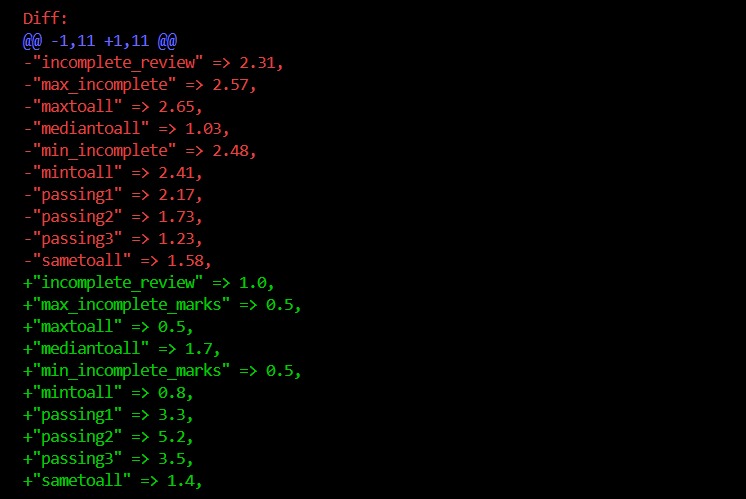CSC/ECE 517 Spring 2024 - E2440 Testing for questionnaire helper, review bids helper: Difference between revisions
| Line 115: | Line 115: | ||
== Objective 1: Develop code testing scenarios for questionnaire_helper == | == Objective 1: Develop code testing scenarios for questionnaire_helper == | ||
== Objective 2: | == Objective 2: Develop code testing scenarios for review_bids_helper == | ||
== Objective 3: Validate the accuracy of the newly implemented Hamer algorithm == | == Objective 3: Validate the accuracy of the newly implemented Hamer algorithm == | ||
Revision as of 16:55, 8 April 2024
This page describes the changes made for the Spring 2024 E2440. Testing for questionnaire_helper, review_bids_helper
Project Overview
Problem Statement
Our project involves writing test cases for the `questionnaire_helper` and `review_bids_helper` files in Expertiza, an open-source assignment/project management portal built on the Ruby on Rails framework. This platform facilitates collaborative learning and feedback among both instructors and students. Instructors can create and customize assignments, define topics for student sign-ups, and manage teams for various projects. Students, on the other hand, can sign up for topics, form teams, and participate in peer reviews to enhance each other's learning experiences. Our goal is to develop comprehensive test plans and increase code coverage for these helper files to ensure their reliability and effectiveness in the Expertiza platform.
Current Code Coverage
- Questionnaire_helper: 66%: https://coveralls.io/builds/66490075/source?filename=app%2Fhelpers%2Fquestionnaire_helper.rb
- Review_bids_helper: 17.65%: https://coveralls.io/builds/66490075/source?filename=app%2Fhelpers%2Freview_bids_helper.rb
Objectives
- Develop test plans/scenarios for questionnaire_helper.rb
- Develop test plans/scenarios for review_bids_helper.rb
- Improve code coverage for questionnaire_helper.rb
- Improve code coverage for review_bids_helper.rb
Files Involved
- Questionnaire_helper.rb: /app/helpers/questionnaire_helper.rb
- Review_bids_helper.rb: /app/helpers/review_bids_helper.rb
Mentor
- Muhammet Mustafa Olmez (molmez@ncsu.edu)
Team Members
- Neha Vijay Patil (npatil2@ncsu.edu)
- Prachit Mhalgi (psmhalgi@ncsu.edu)
- Sahil Santosh Sawant (ssawant2@ncsu.edu)
Class and Method Overview
QuestionnaireHelper
The QuestionnaireHelper module contains several methods to assist with managing questionnaires in expertiza. QuestionnaireHelper provides methods for adjusting advice size, updating questionnaire questions, and creating questionnaire instances based on types. It also defines constants to facilitate these functionalities. These methods are likely used within the application to handle questionnaire-related tasks efficiently. Let's break down the class and its methods:
Constants
CSV_QUESTION, CSV_TYPE, CSV_PARAM, CSV_WEIGHT
- These constants define indices for specific columns in a CSV file.
QUESTIONNAIRE_MAP
- This constant is a hash that maps questionnaire types to their respective questionnaire classes. - It's used by the `questionnaire_factory` method to determine the appropriate class to instantiate.
Methods
1. adjust_advice_size(questionnaire, question)
- This method adjusts the size of advice associated with a given question in a questionnaire.
- Parameters:
- `questionnaire`: The questionnaire object.
- `question`: The question object whose advice size needs adjustment.
- Functionality:
- Checks if the question is a `ScoredQuestion`.
- Deletes any existing advice for the question outside the score range.
- Iterates over the score range and ensures each score has an associated advice.
- Deletes any duplicate advice records.
2. update_questionnaire_questions
- This method updates attributes of questionnaire questions based on form data, without modifying unchanged attributes.
- Functionality:
- Checks for presence of `params[:question]`.
- Iterates through each question and its attributes in the parameters.
- Compares each attribute's current value with the new value from the parameters and updates if changed.
- Saves the question.
3. questionnaire_factory(type)
- This method acts as a factory to create an appropriate questionnaire object based on the type provided.
- Parameters:
- `type`: The type of questionnaire.
- Functionality:
- Retrieves the questionnaire class from `QUESTIONNAIRE_MAP` based on the provided type.
- If the type is not found in the map, it sets an error flash message.
- Otherwise, it initializes a new instance of the corresponding questionnaire class and returns it.
ReviewBidsHelper
This Ruby module, `ReviewBidsHelper` serves as a helper module for views related to reviewing bids in expertiza. `ReviewBidsHelper` provides helper methods for rendering topic rows and determining the background color for topics based on their bid status and the number of participants. These methods are likely used in the views associated with reviewing bids in the application. Let's break down the class and its methods:
Methods
1. get_intelligent_topic_row_review_bids(topic, selected_topics, num_participants)
- This method seems to be responsible for generating HTML markup for a row in a table displaying topics for review bids.
- Parameters:
- `topic`: Represents a specific topic being reviewed.
- `selected_topics`: An array of topics that have been selected.
- `num_participants`: The number of participants involved in the review process.
- Functionality:
- Iterates through the `selected_topics`.
- Depending on the conditions (whether the topic is selected and not waitlisted, or selected and waitlisted), it generates a specific row HTML.
- Returns the generated row HTML as safe HTML.
2. get_topic_bg_color_review_bids(topic, num_participants)
- This method calculates the background color for a topic based on the number of participants and the number of bids for that topic.
- Parameters:
- `topic`: Represents the topic for which the background color is being determined.
- `num_participants`: The total number of participants.
- Functionality:
- Calculates the number of bids for the given `topic`.
- Determines the proportion of bids compared to the total number of participants and adjusts the color accordingly.
- Returns a string representing the RGB value of the background color.
Hamer value calculation
Objective 1: Develop code testing scenarios for questionnaire_helper
Objective 2: Develop code testing scenarios for review_bids_helper
Objective 3: Validate the accuracy of the newly implemented Hamer algorithm
We test the newly implemented Hamer algorithm function with our scenarios and verify if they match the expected values.
Test Code Snippet
describe ReputationWebServiceController do
it "should calculate correct Hamer calculation" do
weights = ReputationWebServiceController.new.calculate_reputation_score(reviews)
keys = ["maxtoall", "mintoall", "mediantoall", "incomplete_review", "sametoall", "passing1", "passing2", "passing3"]
rounded_weights = weights.map { |w| w.round(1) }
result_hash = keys.zip(rounded_weights).to_h
expect(result_hash).to eq(JSON.parse(EXPECTED)["Hamer"])
end
end
Results
Conclusion
The observed results indicate a tendency towards lower values, primarily due to our decision to include nil values and treat them as zeros in our analysis. This treatment has led to a skew in the scores, favoring lower values and potentially impacting the accuracy of our findings. To address this issue and improve the robustness of our analysis, it is advisable to explore alternative approaches such as using median or random values instead of treating nil values as zeros. However, we must also carefully consider how to handle incomplete reviews that contain nil values in our input dataset, as this can significantly influence the overall integrity and reliability of our results and conclusions.
Conclusion
In this project, we aimed to test the accuracy of the Hamer algorithm used for assessing the credibility of reviewers in a peer assessment system. We began by developing code testing scenarios to validate the Hamer algorithm and ensure the accuracy of its output values. These scenarios covered various review scenarios, including cases where reviewers provided extreme scores.
It was established that the original reputation web server was implemented incorrectly.
As a result, we proceeded to reimplement the Hamer algorithm in Ruby, incorporating adjustments to handle nil values appropriately. Subsequently, we validated the accuracy of the newly implemented algorithm using the same testing scenarios. While the results initially showed a skew towards lower values due to our treatment of nil values, we acknowledge the need for further refinement to handle these cases more effectively.
In conclusion, this project highlights the importance of rigorous testing and implementation adjustments in ensuring the reliability of algorithms used in peer assessment systems. Moving forward, we recommend further refinements and validations to enhance the accuracy and robustness of the Hamer algorithm.
Links
Link to Expertiza repository: here
Link to the forked repository: here
Link to pull request: here
Link to Github Project page: here
Link to Testing Video: here
References
1. Expertiza on GitHub (https://github.com/expertiza/expertiza)
2. The live Expertiza website (http://expertiza.ncsu.edu/)
3. Pluggable reputation systems for peer review: A web-service approach (https://doi.org/10.1109/FIE.2015.7344292)




